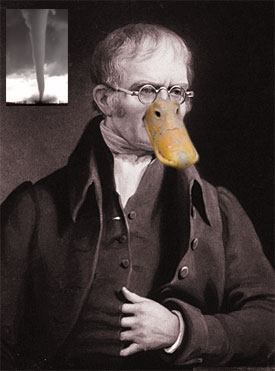John Dalton
John Dalton was one of the most memorable chemists and physicists
of the 18th and 19th centuries. He actually came from very humble
beginnings, being born within a Quaker family that lived in Cumberland,
England. His father was a weaver, but young John Dalton's intelligence
and ambition placed him on the fast track during his early teenage
years.
 John Dalton
John Dalton |
|
For example, he started to run his own Quaker school alongside
his older brother when he was just 15 years old. He wanted to
pursue a career in law or medicine from an early age, but he was
met with a lot of opposition from his close relatives and friends.
He also found out later in life that he suffered from a very rare
form of color blindness (deuteroanopia) in which he was able to
only identify yellow colors. However, John Dalton did not allow
these minor setbacks to stop him from pursuing his dreams and
striving to reach his peak potential in life.
An Ambitious Journey of Learning
Dalton followed in the footsteps of a close mentor and friend,
Elihu Robinson, who was a very prominent Quaker at the time that
was widely known for his skills in meteorology and instrument
making. Robinson was the one that influenced Dalton to go against
the grain and ignore the opposition that he received from his
family in order to pursue his interests in mathematics, science
and meteorology as well. This journey led him towards making several
significant strides within the world of science in the years to
come.
John Dalton's early experiments focused on being able to measure
the pressure of steam at different points of temperature ranging
between 32 and 212 degrees Fahrenheit (or 0 and 100 degrees Celsius.)
He was able to conclude from these experimentations that the standard
variation of vapor pressure within every single liquid is equivalent.
He was able to use his studies to further improve on the studies
that had already been published by scientists and physicists that
came before him, such as Joseph Louis Gay-Lussac - the scientists
that developed the Gay-Lussac's Law. However, it was John Daltons'
work on his atomic theory within the world of chemistry that earned
him a place in the science textbooks throughout history.
Dalton's Atomic Theory
There were five key points that John Dalton was able to develop
within the atomic theory. The first point was that there were
many different elements that were made out of very tiny small
particles that were named atoms. The second point of Dalton's
atomic theory was that those atoms within a specific element are
actually identical in mass, size and a variety of other properties
as well. The third point concluded that atoms are not able to
ever be created, destroyed or even subdivided regardless of what
may happen to them through experimentations and other research
studies.
The fourth point of Dalton's atomic theory showed that a variety
of different atoms within a wide variety of elements are able
to combine in whole number ratios in order to mathematically create
chemical compounds. The final point of this widely known theory
that is still being taught in science classes around the world
today is that, within a chemical reaction, atoms are separated,
combined and also rearranged.
Rumor Has It …
Rumor has it that John Dalton was the first creator of the made
for TV movie Sharknado except in his version everyone was
dressed as a Quaker and instead of sharks, ducks were flying out
of tornadoes eating everyone. He called it Quacknado.
Written by Kevin Lepton
|

